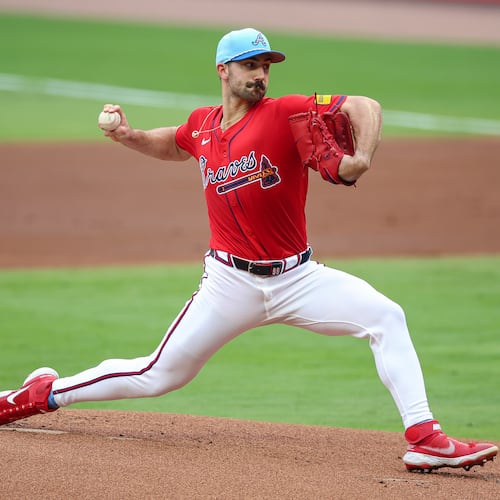Through 58 games, the Atlanta Braves had scored one or no runs 19 times – or once every three games,. After his team lost to Seattle 2-0 on Wednesday, manager Fredi Gonzalez said: “We’ve been shut out seven times, and we’re a team that shouldn’t be shut out because we’ve got so many talented offensive players.”
The Braves entered Friday night’s game in Phoenix ranked 29th among 30 major-league teams in runs and 26th in on-base percentage. They haven’t stopped hitting; they never really started. They lost the season opener in Milwaukee 2-0 on March 31. This isn’t a team having a bad offensive month. This is – or at least has been – a bad offensive team.
What can be done? Well, Frank Wren can trade for a hitter, though with the money invested in the majority of this everyday eight, it’s unclear what position an import would occupy. The Braves just played the Tommy La Stella card, summoning the singles hitter from Gwinnett and installing him at second base. Now that Dan Uggla no longer starts, sitting a starter isn’t an option. The Braves’ reserves hit even less than their regulars.
The only course discernible from this perch is to reconfigure the batting order, but we stipulate that such a shuffle might have no effect. I took the liberty of soliciting the help of Ben Lindbergh, editor-in-chief of the truly excellent Baseball Prospectus, and this was his sobering response:
“I just surveyed a few stat people at BP, and the first couple responses observed, rightly enough, that as long as you’re not batting your pitcher leadoff and your best hitter ninth, the differences between ‘optimal’ and ‘suboptimal’ are small, usually on the order of a few runs a year. We focus on them because – unlike luck, injuries, et cetera – they’re something the team can fully control. It makes sense to eke out every edge you can, and it’s frustrating when managers seemingly leave runs on the board. However, the differences are usually small enough that they might be outweighed by clubhouse/psyche concerns and players’ personal preferences.”
The other day I mentioned to Gonzalez that I might have La Stella bat second behind Jason Heyward. Said Gonzalez: “Then you’ve got three left-handers in a row (counting Freddie Freeman in the No. 3 spot).” And those aren’t just three lefties; they’re the only three among this everyday eight. Where have you gone, Brian McCann? (Oh, right. To the Bronx.)
The point being: For what ails these Braves, there’s no simple fix and maybe no fix. But sticking with what isn’t working wouldn’t seem a plan – unless the Braves’ intention is to waste much of the work produced by baseball’s best rotation. Not that you asked, but here’s what I’d do:
1. Heyward, RF: He mightn’t seem a leadoff man, but you know what a leadoff man does? He gets on base. Heyward has an OBP of .339, up from .301 on May 10. That’s why he stays here, as opposed to B.J. Upton, who has an OBP of .291 and who has stuck out 68 times. As for Andrelton Simmons: He doesn’t strike out but doesn’t walk; his OPB was .292, almost the same as Upton’s.
2. La Stella, 2B: The Braves don’t want to throw too much at the rookie, which is one reason I didn’t consider him for the No. 1 spot. Another: La Stella is no threat to run, which means him reaching base to start an inning wouldn’t have the effect of Heyward doing it. But a singles hitter makes more sense at No. 2 than B.J. Upton, who can’t be counted on to produce the “hit” element of a hit-and-run.
3. Justin Upton, LF: Even as I acknowledge Gonzalez’s objection, this tweak isn’t entirely a lefty-righty thing. Although Freeman is considered the Braves’ best hitter, Upton has slightly outperformed him. According to Baseball Reference, Upton’s offensive WAR (wins above replacement) rating is 1.8; Freeman’s is 1.3.
4. Evan Gattis, C: My inclination was to switch Justin Upton and Freeman in the order, but Russell Carleton, the piquant Baseball Prospectus author who lives in Atlanta, talked me out of it. “Just flipping Upton and Freeman doesn’t solve the (lefty/righty) problem,” Carleton wrote. “In a key situation, which is what we’re really talking about, that sounds like an intentional walk to Justin Upton waiting to happen.” Also I don’t like having no lefty hitter in the order after the No. 4 spot.
5. Freeman, 1B: I’m not crazy about this; I just can’t find anything I like more. (Or, more precisely, dislike less.) And it’s not, I remind you, as if I’m tinkering with the Big Red Machine.
6. Chris Johnson, 3B: Because somebody has to hit sixth.
7. Simmons, SS: He’s still developing as a hitter – he pitched in junior college and some thought his future would be as a pitcher – but he’s not yet a top-of-the-order guy and might never be. Which is OK, given that he’s the best shortstop in the business.
8. (Pitcher): Gonzalez tried this for eight games and it didn’t move the needle. It’s worth trying again because of who’ll be hitting ninth.
9. B.J. Upton, CF: A $75 million non-pitcher batting ninth? Yes, and here’s why: If he strikes out, it’s no big deal. You expect your No. 9 hitter to whiff. If Upton gets a hit, he hands an RBI chance to Heyward, who drove in 82 runs in 2012 but has only 17 this season.
Yes, there are problems. Once past Freeman at No. 5, this altered batting order is no less thin than before. And here’s where I return to the appraisal offered by Carleton that almost made me abandon the exercise. “The Braves’ problem isn’t lineup construction,” he wrote. “It’s lousy hitters.”
About the Author
Keep Reading
The Latest
Featured


